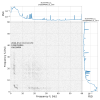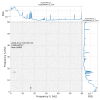I was able to request and transition to the new DARM state without issue. ETMX still saw a pretty large kick. I'll have to circle back re: how large compared to previous attempts. We will also want to take a look at any effects moving the integrator on L2 LOCK L had. Note: We do get a few SUS_PI warnings shortly after transitioning to this state. Quiet time to monitor for non-stationarity: Start GPS: 1394344327 Stop GPS: 1394346169 Turned off cal lines at GPS 1394346770.39 Elenna started a Bruco after the cal lines were turned off. here is a screenshot of DARM in the new configuration. 20-90Hz looks high and below 15Hz looks low. It's hard to tell how much of this is real until CAL-CS is calibrated & that calibration is propagated to the DTT template. I started an L2 LOCK IN1/IN2 injection using noise recorder at 1394347034.426. We used a tuned broadband measurement that Craig and I put together. Apparently it was too strong because we lost lock from this injection. It also tripped EX. I requested DOWN and the EX trip alarm reset.
Bruco is here: https://ldas-jobs.ligo-wa.caltech.edu/~elenna.capote/brucos/New_DARM/
Just from first glance looks like some residual LSC coherence, but not enough to explain the strange shape of New DARM.
Here are plots comparing the MASTER OUTS on ETMX during Louis's quiet time here with L3 offloaded, vs Gabriele's quiet time in alog 76278 during Nominal DARM. We are concerned only with the filter changes that Louis and Sheila made to offload more of L3's length actuation onto L2. Because L2 is used to control both length and angular degrees of freedom, it can be easy to ask too much of L2. This lock seems to indicate that this configuration is fairly stable. I looked at the UL MASTER OUTs for the L1, L2, L3 on ETMX. 1) RMS on L3 drives is halved. There is much less L3 drive from 1 to 6 Hz, which dominates the RMS. 2) L2 drives are largely unchanged. 3) L1 drives are changed, but the RMS remains similar. There is much less HF content in the L1 drive with L3 offloaded, and the shape of the resonances around 3 and 6 Hz is altered. Overall it's hard to tell which stage is picking up L3's slack from these PSDs. I believe the intention was to offload to L2, but we don't see any obvious change in what control signal is being sent to the L2 stage. This could simply mean that the angular controls are relatively stronger in the L2 controllers. We'll look at the DRIVEALIGN signals to try and figure that one out quantitatively.
The new DARM loop configuration reduces the DARM noise non-stationary at low frequency.
First plot compares the ESD drive with the Old DARM and the New DARM, confirming that the RMS is significantly reduced, especially at the relevant frequencies.
Second and third plots are spectrograms and whitened spectrograms of GDS-CALIB_STRAIN in the two configuration. Despire GDS-CALIB_STRAIN being wrongly calibrated with the New DARM, it is clear that the low frequency non stationarity is gone in New DARM.
Last two plots are the bicoherence of DARM with the ESD drives, showing that in the Old DARM there is still some bicoherence for noise in the 10-30 Hz region, while in the New DARM this is gone.
These transitions last night were made with a different L2 LOCK filter (which is in L2 LOCK L FM6, replacing the filter used in earlier new DARM configurations that was at FM2). The attached screenshot shows the filter change, I replaced the poles at zero with poles at 0.03 Hz to get rid of the integrator here without changing the phase at the crossover much. This was done with the guardian version 27211
Plots of the actuators during the transitions are attached, here and here, they can be compared to the one that Louis posted where we used L2 LOCK FM2. This suggests that the change to these poles didn't help to reduce the transient during the transition.
Today we tried another change to the transition, this time Evan and I moved the poles in L2 LOCK L from 0.03 Hz to 0.1 Hz, and changed the ramp time for the transition to 10 seconds (from 5). The model is shown in the attached PDF where the new filter is in place in the transition traces. This transition wasn't smoother than the others, see here.
The new UGF is 70 Hz with 20° of phase margin. The crossover between L2 and L3 is at 18 Hz with probably about 40° of phase margin (low coherence due to interference with calibration lines). We have not measured the L1 to L2 crossover yet.
S. Dwyer, E. Capote, E. Hall, S. Pandey, L. Dartez
Here are some notes from our efforts to measure IN1/IN2 at the L1 LOCK L input.
- Sheila adjusted UIM measurement template for new darm config. This template is at /opt/rtcds/userapps/release/lsc/h1/templates/DARM/UIM_crossover.xml.
- Evan ran the template initially and saw that the UGF is near 1Hz. He adjusted the excitation amplitude along the way to improve coherence for the next time we run this measurement.
- Evan added a high pass filter in the L3 DRIVEALIGN bank with a cutoff frequency at at 5Hz
- first filter attempt was at 8Hz; possibly caused a roll mode to excite near 13.75Hz
- second filter attempt was at 5Hz; this seemed to improve the roll mode excitation
We ended up losing lock a shortly after the injection finished due to PRC activity.
Comparison of DARM ESD drive from end of O4a versus a few days ago. The microseism was about 0.2 µm/s in both cases. The rms DAC drive from 0.1 Hz to 0.3 Hz is about 400 ct, so even in cases of exceptionally high microseism it will be subdominant to the 7000 ct rms that is accumulated above 1 Hz.
















































